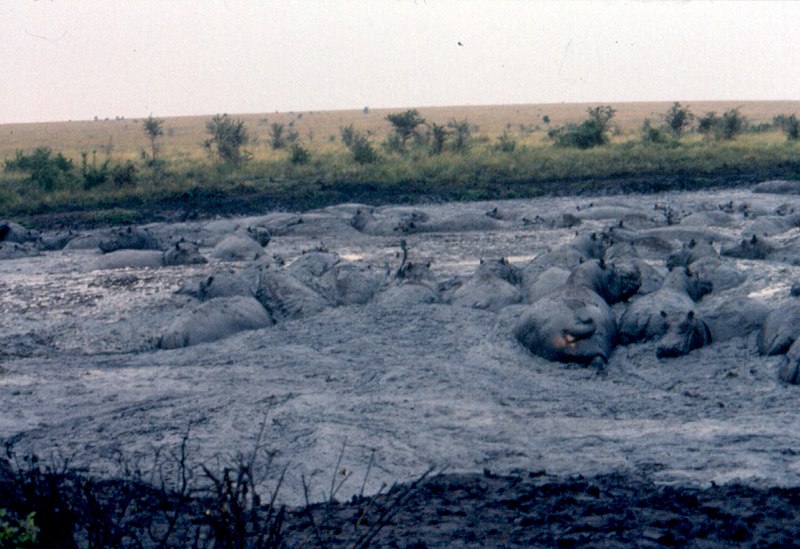File:Hippopotamus Rwindi 20.jpg

Original file (2,263 × 1,554 pixels, file size: 3.01 MB, MIME type: image/jpeg)
Captions
Captions
Summary[edit]
| DescriptionHippopotamus Rwindi 20.jpg |
English: The hippopotamus (Hippopotamus amphibius) or hippo (Greek: ἱπποπόταμος, hippopotamos, from ἵππος, hippos, "horse" and ποταμός, potamos, "river") is a large, mostly plant-eating African mammal.
The hippopotamus is semi-aquatic, inhabiting rivers and lakes in sub-Saharan Africa in groups of 5-30 hippos. The hippopotamus also uses water to keep itself hydrated and able to carry out his life functions. During the day they remain cool by staying in the water or mud. They emerge at dusk to graze on grass. This photo was taken in Rwindi National Park, part of the immense National park of Virunga, in the Democratic Republic of Congo.Digitized slide.Nederlands: Het nijlpaard (Hippopotamus amphibius) is de grootste en meest algemene soort uit de familie der nijlpaarden (Hippopotamidae).
Nijlpaarden leven in en om het water, in rivieren, plassen, meren en moerassen in een groot deel van Afrika, oorspronkelijk van de Nijldelta tot de Kaap. Ze komen oorspronkelijk in ieder gebied voor waar voldoende water is om in te baden en gras om van te grazen. In bergen kunnen ze tot op 2000 meter hoogte worden gevonden. Overdag verblijft het nijlpaard in het water. 's Nachts verlaat het het water om te grazen. Het nijlpaard graast bij voorkeur solitair op korte grasvelden. Deze foto werd genomen in het Rwindi Nationaal park, deel van het Virunga Nationaal Park. Gedigitaliseerde dia.Français : L'hippopotame (Hippopotamus amphibius) amphibie est un mammifère herbivore semi-aquatique d'Afrique.
L'hippopotame passe ses journées dans des groupes d'une vingtaine d'individus dans l'eau douce et boueuse. Il se nourrit sur la terre ferme, s'y aventurant surtout la nuit. Photo pris au Parc National du Rwindi, part de la Parc national du Virunga.Deutsch: Das Flusspferd (Hippopotamus amphibius), auch Nilpferd oder Großflusspferd genannt, ist ein großes, pflanzenfressendes Säugetier. Es lebt in Gewässernähe im mittleren und südlichen Afrika und zählt nach den Elefanten zu den schwersten landbewohnenden Säugetieren.
Flusspferde verbringen praktisch den ganzen Tag schlafend oder ruhend, dazu halten sie sich im Wasser oder in Gewässernähe auf. Vorwiegend in der Nacht verlassen sie das schützende Wasser, um sich auf Nahrungssuche zu begeben. Photo genommen im Rwindi Nationalpark in der Democratische Republik Congo.Afrikaans: Die seekoei (Hippopotamus amphibius) is 'n groot, oorwegend plantetende Afrika-soogdier. De naam kom vanaf die Grieks ἱπποπόταμος -- hippopotamos, waar hippos "perd" beteken en potamos "rivier" beteken.
Die seekoei is halfwaterliewend en woon in groepe van vyf tot dertig diere in riviere en mere in Afrika suid van die Sahara. Bedags verkoel hy homself deur in die water of modder te bly. Die diere verskyn teen skemer aan wal om gras te vreet. Hoewel groepsverband en -gebied in die water geld, vreet seekoeie alleen op land, sonder beskerming van grondgebied. Foto uit die Rwindi Nationaal park in die Democratische Republiek Congo. |
|||
| Date | ||||
| Source | Own work | |||
| Author | Ad Meskens | |||
| Permission (Reusing this file) |
Notification/copy of publication is appreciated
|
Licensing[edit]
- You are free:
- to share – to copy, distribute and transmit the work
- to remix – to adapt the work
- Under the following conditions:
- attribution – You must give appropriate credit, provide a link to the license, and indicate if changes were made. You may do so in any reasonable manner, but not in any way that suggests the licensor endorses you or your use.
- share alike – If you remix, transform, or build upon the material, you must distribute your contributions under the same or compatible license as the original.

|
Permission is granted to copy, distribute and/or modify this document under the terms of the GNU Free Documentation License, Version 1.2 or any later version published by the Free Software Foundation; with no Invariant Sections, no Front-Cover Texts, and no Back-Cover Texts. A copy of the license is included in the section entitled GNU Free Documentation License.http://www.gnu.org/copyleft/fdl.htmlGFDLGNU Free Documentation Licensetruetrue |
File history
Click on a date/time to view the file as it appeared at that time.
| Date/Time | Thumbnail | Dimensions | User | Comment | |
|---|---|---|---|---|---|
| current | 08:03, 3 May 2009 |  | 2,263 × 1,554 (3.01 MB) | Ad Meskens (talk | contribs) | {{Information |Description={{en|1=a}} |Source=Own work by uploader |Author=Ad Meskens |Date= |Permission=Notification/copy of publication is appreciated |other_versions= }} <!--{{ImageUpload|full}}--> [[Category:Hippopotamus amphibius] |
You cannot overwrite this file.
File usage on Commons
The following page uses this file:
Metadata
This file contains additional information such as Exif metadata which may have been added by the digital camera, scanner, or software program used to create or digitize it. If the file has been modified from its original state, some details such as the timestamp may not fully reflect those of the original file. The timestamp is only as accurate as the clock in the camera, and it may be completely wrong.
| Orientation | Normal |
|---|---|
| Horizontal resolution | 72 dpi |
| Vertical resolution | 72 dpi |
| Software used | Adobe Photoshop CS2 Windows |
| File change date and time | 00:47, 12 April 2009 |
| Color space | sRGB |
